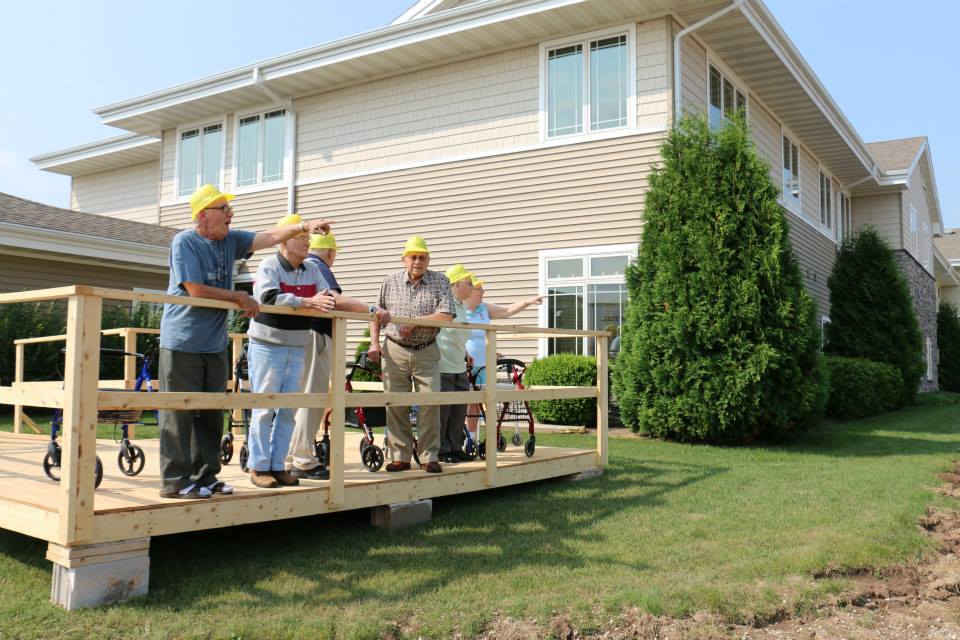Choosing a care provider for your loved one’s future is never easy. There are many providers that offer various levels of care, making finding the most appropriate fit a bit overwhelming. Our team at Pine Haven put together a guideline of the differences between independent living, supported independent living, and assisted living to help you make the right choice for your loved one.
What is Independent Living?
Independent living provides seniors with flexibility in their lifestyle in an environment where they can form new connections. It is designed for active and physically independent seniors who require no assistance with activities of daily living.1

Housing accommodations
The focus of independent living accommodations is to function as a private residence with social opportunities.2
Independent living services at Pine Haven are provided within our Prairie Crossing apartments and Oostburg duplexes. These housing accommodations are for seniors looking to downsize to a more compact lifestyle. There are little to no worries about maintenance or yard work as the community, like Pine Haven, would provide these services.
Amenities and activities
Seniors living in independent living accommodations are provided with the option to join community activities like musical performances or continuing education classes. Depending on the housing accommodations (i.e., apartment versus duplex), amenities like large sitting rooms, recreational areas, and salons may be offered, along with services like light housekeeping and laundry. For active seniors, additional exercise services may also be available within a separate exercise area or gym.3
What is Supported Independent Living?
What if you or a loved one needs more care? The next step would be supported independent living services (SIL) provided in a certified or registered Resident Care Apartment Complex (RCAC). Supported independent living is considered a type of assisted living. This level of care is designed for seniors who need extra support while trying to maintain as much independence as possible.4
The most significant difference between supported independent living and independent living is the amount of professional medical care and services provided per week.

Housing accommodations
As the name implies, seniors who reside in a Resident Care Apartment Complex (RCAC) become tenants and live in individual apartments. The apartment provided must have a lockable entrance and exit, a kitchen, a separate bathroom, and sleeping and living areas.5
Amenities and activities
Seniors who live in supported independent living complexes may have similar accommodations as seniors who live in independent living. Much like independent living, this type of community may offer activities to maintain physical health, intellectual stimulation like book clubs, and social opportunities like devotions and happy hours.6
Care needs
Seniors entering supported independent living services must be designated as competent and must not require more than 28 hours of care and facility-provided services per week.
Care and facility-provided services per week includes access to community services, recreational activities, general housekeeping, and transportation. It also includes professional services helping seniors with daily living activities such as dressing, aiding during meals, bathing, and grooming. Nursing services, delivered by a registered nurse, also provide health monitoring assessments and medication management to all tenants. Emergency assistance is also included, and staff must ensure the health and safety of each tenant 24 hours a day.7
What is Traditional Assisted Living?
Seniors or residents who enter traditional assisted living accommodations are provided with even more care in a community setting compared to independent and supported independent living. However, the amount of care is not as much as a senior who resides in a nursing home.

Housing accommodations
Assisted living residents living in Community Based Residential Facility (CBRF), live in their own rooms and share common areas. The overall feel of traditional CBRFs is to accommodate specific care needs the resident may require within a homelike environment.8
Amenities and activities
Residents are provided with three meals a day, assistance with personal care, medication management, and social and recreational activities. Assisted living facilities designate communal areas like libraries, dining rooms, and beauty and barbershops to provide socialization. Housekeeping, laundry, and maintenance services are also offered in an assisted living.9
Care needs
Residents are encouraged to remain as independent as possible within this setting. Residents are offered assistance with daily living activities and provided security measures around the clock. Unlike supported independent living services, assisted living may provide up to 3 hours of specific skilled nursing services and unlimited care hours per week.10 These nursing services can include a more intensive medication management regimen along with a medical care plan. These services are executed with the help of medical professionals associated with the senior’s overall care.11

At Pine Haven Christian Communities, we are proud to provide a full continuum of care that incorporates these levels and more to accommodate your loved one when the time is right. Our Prairie Crossing, Oostburg, and Sheboygan Falls locations provide independent living, supported independent living, and traditional assisted living with various amenities and housing accommodations tailored to your needs.
For any questions about our Pine Haven campuses, contact us today!
